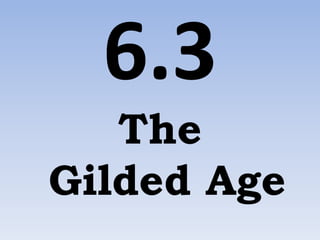
6.3 gilded age
- 3. The Gilded Age This is the term used to describe America between 1870 to 1900. It was a time when industry expanded, cities grew larger, skyscrapers were built, electric lights lined the streets, and subway cars ran underneath the streets. Corruption dominated American life
- 5. Mark Twain His real name was Samuel Clemens. He was an author who wrote many great books including: 1. The Adventures of Huckleberry Finn 2. Tom Sawyer 3. The Gilded Age: A Tale of Today He was born in Florida Missouri on November 30th 1835 and later moved to Hannibal Missouri on the Mississippi River. Mark Twain died on April 21st 1910 in Redding Connecticut.
- 7. Social Darwinism Social Darwinism – took Darwin’s theory of survival of the fittest and applied it to individuals So…if you were poor, whose fault was it? YOUR OWN!!!!!! Herbert Spencer
- 8. The “Gospel of Wealth” Created by Andrew Carnegie Believed the rich should use their money to help the poor Carnegie was known for building libraries, hospitals, schools, etc
- 9. Popular Culture in the Gilded Age
- 10. Art --- REALISM
- 14. AMUSEMENT PARKS Amusement Parks became popular like Coney Island in New York City.
- 17. Baseball Watching professional baseball became the national pastime. The first modern World Series was played in 1903 between the Red Sox & Pirates.
- 18. 1903 Pirates – They didn’t invent the middle part hair cut, they just mastered it.
- 21. 1891 – James Naismith
- 22. Rag Time Music, Scott Joplin "King of Ragtime" Ma Ragtime Baby
- 23. Helping the Poor William Booth started the Salvation Army around 1878. The Salvation Army would provide food, clothing, and religious counseling to the poor. The Young Men’s Christian Association (YMCA) was started to aid the poor also. The Y would have gymnasiums, libraries, and hotels to those who needed the service. Both of these groups were religious in nature and believe that the way to help the poor was not by giving them stuff, but rather by reforming their souls.
- 24. YMCA
- 25. Jane Adams and the Hull House Jane Addams founded the Hull House in Chicago. 1st women to be awarded the Nobel Peace Prize The Hull House would provide day care, kindergartens, English classes, and recreation for the poor. A community of college educated women lived there and provided TONS of services
- 26. Jane Addams
- 27. The Hull House
- 29. Public Education With the rise of factories and immigration, there was a demand for educated people. Schools were important to Americanize immigrants. That means to teach them English, American History, and how to be good citizens. Many children living in small farming towns did not receive the same education as a student living in a large city. High schools in urban areas tended to be focused on training kids to grow up into good workers
- 31. Election of 1880 James A. Garfield won the election. He refused to give jobs to those people closely linked to his party. Charles Giteauwas wanting Garfield to give him a job. Garfield refused. Giteau shot the President at a train station on July 2, 1881. He said that Garfield’s death was a political necessity.
- 32. Guiteau learned from newspaper reports on June 30 that President Garfield would be catching a 9:30 A.M. train at the Baltimore and Potomac Station the following morning. He wrote a second justification for his planned assassination or, as he called it, "the President's tragic death." Guiteau, claiming himself to be "a Stalwart of the Stalwarts," wrote that "the President...will be happier in Paradise than here." He ended his note with the words "I am going to jail."Guiteau arrived at the station about 8:30. He felt ready for the job, having practiced his marksmanship on a river bank on the way to his destination. Garfield entered the nearly empty station at 8:25 with Secretary Blaine and a bag-carrying servant. They had walked several steps into the carpeted "ladies' waiting room" when Guiteau fired his first shot. It grazed Garfield's arm. Guiteau moved two steps and fired a second shot. The bullet entered Garfield's back just above the waist. The president fell as the back of his gray summer suit filled with blood. As confusion erupted in the station, Guiteau tried to reassure onlookers: "It is all right, it is all right." The police officer on duty grabbed Guiteau.
- 34. Charlie Gizzle
- 36. Election of 1884 Chester A. Arthur became the President when Garfield was shot. Arthur decided not to run for office in 1884. The election was between Grover Cleveland (D) and James Blaine (R) Blain was rumored to have accepted bribes in previous political positions Cleveland won. He was the first democrat elected since before the Civil War. Cleveland was supposed to be an honest man who would begin to help the “little guys” in business
- 37. Grover Cleveland
- 38. Bad Economic Times Interstate Commerce Act – created the ICC to regulate interstate commerce. Didn’t allow railroads to charge higher rates for smaller companies that shipped smaller volume. The McKinley Tariff was a bill that cut tariffs on many goods, but raised tariffs on others (like textiles) Ended up raising prices overall and being bad for Americans The Sherman Anti-trust Act was created to stop the development of large businesses. However, this Act did not have a real immediate impact.
- 39. 1888 Benjamin Harrison Elected